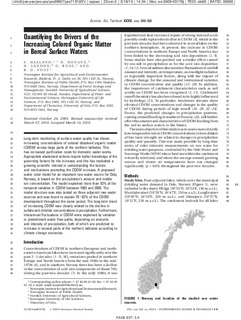| dc.contributor.author | Haaland, Ståle Leif | |
| dc.contributor.author | Hongve, Dag | |
| dc.contributor.author | Laudon, H | |
| dc.contributor.author | Riise, Gunnhild | |
| dc.contributor.author | Vogt, RD | |
| dc.date.accessioned | 2018-04-11T09:44:42Z | |
| dc.date.available | 2018-04-11T09:44:42Z | |
| dc.date.created | 2010-06-01T13:28:15Z | |
| dc.date.issued | 2010-03-23 | |
| dc.identifier.citation | Environmental Science and Technology. 2010, 44 (8), 2975-2980. | nb_NO |
| dc.identifier.issn | 0013-936X | |
| dc.identifier.uri | http://hdl.handle.net/11250/2493594 | |
| dc.description.abstract | Long-term monitoring of surface water quality has shown increasing concentrations of colored dissolved organic matter (CDOM) across large parts of the northern latitudes. This has increased purification costs for domestic water works. Appropriate abatement actions require better knowledge of the governing factors for the increase, and this has motivated a growing scientific interest in understanding the factors and mechanisms promoting the CDOM increase. A proposed water color model for an important raw water source for Oslo, Norway, is based on the precipitation’s amount and mobile ion concentration. The model explained more than 93% of the temporal variation in CDOM between 1983 and 2008. The model structure was also tested on three adjacent raw water sources and was found to explain 75−82% of the CDOM development throughout the same period. The long-term trend of increasing CDOM was closely related to the decline in sulfate and chloride concentrations in precipitation. Furthermore, interannual fluctuations in CDOM were explained by variation in predominant water flow paths, depending on amounts and intensity of precipitation, both of which are predicted to increase in several parts of the northern latitudes according to climate change scenarios. | nb_NO |
| dc.language.iso | eng | nb_NO |
| dc.publisher | American Chemical Society | nb_NO |
| dc.title | Quantifying the drivers of the increasing colored organic matter in boreal surface waters | nb_NO |
| dc.type | Journal article | nb_NO |
| dc.type | Peer reviewed | nb_NO |
| dc.description.version | acceptedVersion | nb_NO |
| dc.rights.holder | © 2010 American Chemical Society | nb_NO |
| dc.source.pagenumber | 2975-2980 | nb_NO |
| dc.source.volume | 44 | nb_NO |
| dc.source.journal | Environmental Science and Technology | nb_NO |
| dc.source.issue | 8 | nb_NO |
| dc.identifier.doi | 10.1021/es903179j | |
| dc.identifier.cristin | 338347 | |
| dc.relation.project | Norges forskningsråd: 190028 | nb_NO |
| cristin.ispublished | true | |
| cristin.fulltext | original | |
| cristin.qualitycode | 2 | |
